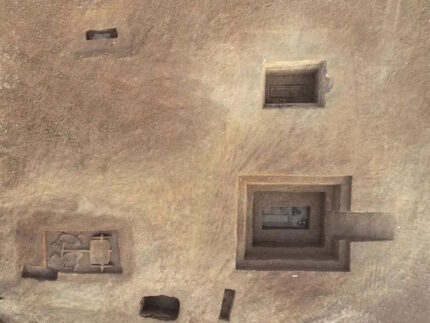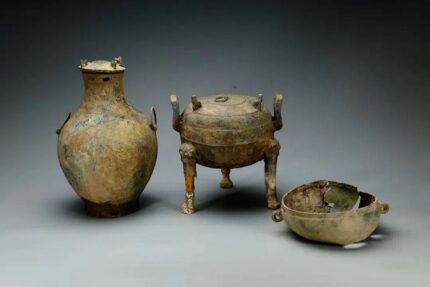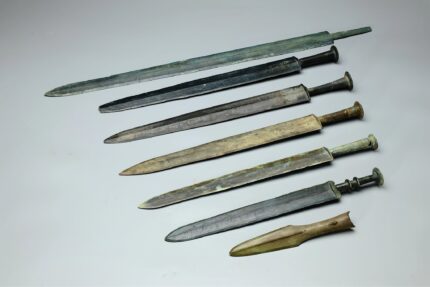A large cemetery from the Warring States Period (475–221 B.C.) has been discovered in Xiangyang City, Hubei Province, central China, with finely furnished graves and one chariot burial.
 Archaeologists from the Xiangyang Municipal Institute of Cultural Relics and Archaeology discovered the Baizhuang Cemetery in an excavation associated with an infrastructure project in June and July 2023. Excavations resumed in November 2023 in collaboration with the Hubei Provincial Institute of Cultural Relics and Archaeology, and after a comprehensive exploration of the site, 176 tombs were unearthed. All but two of them were earthen pit tombs from the Warring States Period. The two exceptions date to the Han Dynasty (202 B.C. – 9 A.D., 25–220 A.D.).
Archaeologists from the Xiangyang Municipal Institute of Cultural Relics and Archaeology discovered the Baizhuang Cemetery in an excavation associated with an infrastructure project in June and July 2023. Excavations resumed in November 2023 in collaboration with the Hubei Provincial Institute of Cultural Relics and Archaeology, and after a comprehensive exploration of the site, 176 tombs were unearthed. All but two of them were earthen pit tombs from the Warring States Period. The two exceptions date to the Han Dynasty (202 B.C. – 9 A.D., 25–220 A.D.).
Most of the Warring States tombs, 165 of them, are small pits between and six and eight feet long and 1.5 and six feet wide. Nine of them are significantly larger and have sloped passageways leading into them. The three largest (dubbed M1, M2 and M3) are between 31 and 34 feet long, including passageways, and between 17 and 21 feet wide.
 M3 and M4 once contained wood coffins that have decayed leaving only blue-gray marks in the earthen platforms attesting to their presence, but the tombs are furnished with ample bronze grave goods. M3 contained 11 pieces of metalware, including bronze tripods, pots, boats, horse bits, swords, spears and spoons. M4 had a trio of bronze tripod, pot and boat.
M3 and M4 once contained wood coffins that have decayed leaving only blue-gray marks in the earthen platforms attesting to their presence, but the tombs are furnished with ample bronze grave goods. M3 contained 11 pieces of metalware, including bronze tripods, pots, boats, horse bits, swords, spears and spoons. M4 had a trio of bronze tripod, pot and boat.
The tombs excavated this time were densely distributed and neatly arranged, and a number of important cultural relics were unearthed. A bronze sword, horse bit, etc. were unearthed from M3, so it is inferred that the owner of the tomb is a male. Based on the size of the M3 tomb, the combination of bronze ritual vessels and the chariot and horse pits, it is speculated that the owner of the tomb should belong to the first-level nobleman. M4’s status is obviously lower than M3, and he may be M3’s spouse. The M1 tomb is the largest in scale. Although no copper ritual vessels were buried with it, not only did it use green paste clay in the tomb, but it also had the largest number of burial objects. The identity of the tomb owner should be close to that of M3.
 Just 24 feet northwest of M3, archaeologists found a chariot and horse burial dubbed CHMK1, also from the Warring States Period. The burial contained one wooden cart, now completely decayed, and the partial skeletal remains of two horses. The horses were place on either side of the chariot shaft back-to-back. Archaeologists believe the horses were dead before burial.
Just 24 feet northwest of M3, archaeologists found a chariot and horse burial dubbed CHMK1, also from the Warring States Period. The burial contained one wooden cart, now completely decayed, and the partial skeletal remains of two horses. The horses were place on either side of the chariot shaft back-to-back. Archaeologists believe the horses were dead before burial.
In total, more than 500 artifacts were unearthed in the cemetery excavation, most of them pottery. About 40 bronze objects — ritual vessels, swords, spears — were recovered, as were six pieces of wooden daily utensils — combs, wire-winding rods — and jewelry like jade rings.